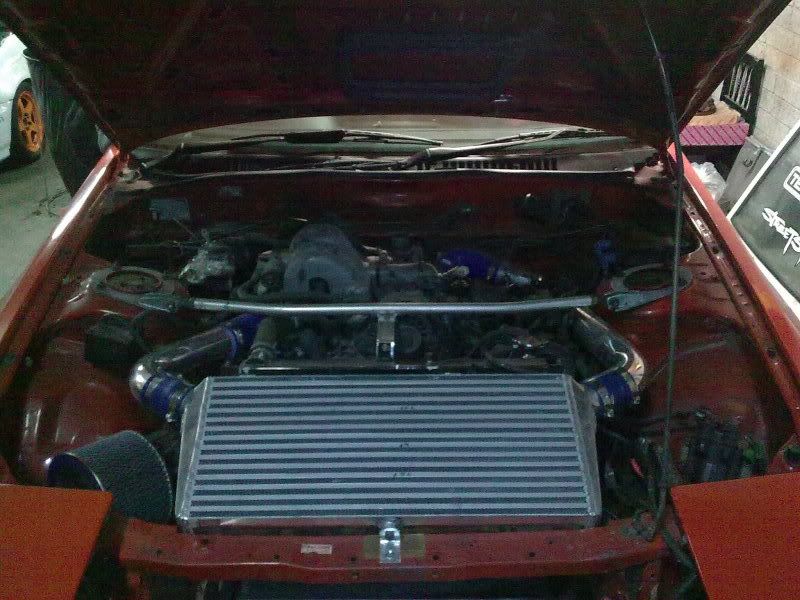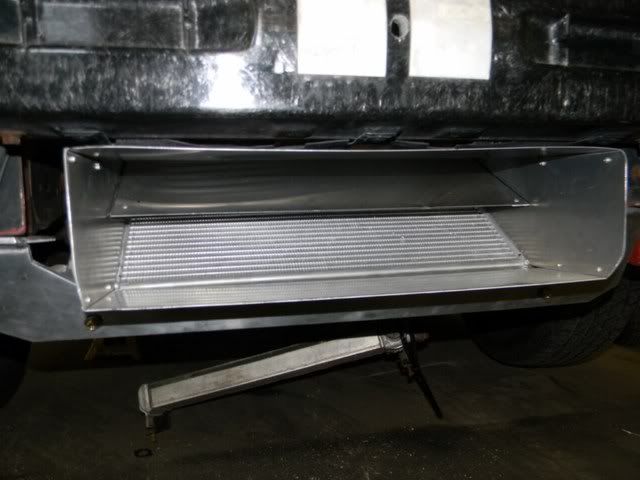Intercooler location (oposite v-mount)
#1
Thread Starter
Joined: Jul 2007
Posts: 67
Likes: 0
From: Prague (Czech Republic)
Intercooler location (oposite v-mount)
Hi all, after I saw this configuration somewhere on internet, I want to ask for posible benefits of this configuration. For me it looks interesting and easy to do and should be more efficient then stock with ok air to air intercooler and ducting opening under stock mount water radiator. What is your opinion on this setup?
#2
It would work OK if you have a ducted hole in the hood.
The car would look weird though.
Also, you woudn't get as much airflow as a regular FMIC. It's too far from parallel to the air flow, without enough ducting.
I think you'd be better off mounting something on top of the engine near the stock location with a big hood scoop.
The car would look weird though.
Also, you woudn't get as much airflow as a regular FMIC. It's too far from parallel to the air flow, without enough ducting.
I think you'd be better off mounting something on top of the engine near the stock location with a big hood scoop.
#3
Thread Starter
Joined: Jul 2007
Posts: 67
Likes: 0
From: Prague (Czech Republic)
I forgot that, i have Foresight bonnet with hole behind Radiator, which i used to have since my N/A FC. I was looking to do v-mount, but this looks like a good idea to me.
#4
You'd be feeding the intercooler with very slow, very hot air instead of very fast, very cold air that both the stock mount and front mount intercoolers would get. A V-Mount would be better, but costs more and requires more work.
#7
"Puller" fans are the most desirable config, "pusher" if you must, but not both at the same time.
In your drawing you show an open gap in the ductwork, theoretically improving flow to the intercooler.
Not sure what effect this may have on the intercooler but it will for sure hurt the radiator. Air is lazy and will invariably seek the path of least resistance, in this case, the shortcut around the rad that you so thoughtfully provided.
It seems likely that this layout will also somewhat raise pressure behind the radiator, further hurting flow through it.
Naturally, the proof is in the pudding, so have at it and see.
Trending Topics
#8
I like your illustration. I've often thought about this set-up a few times before... It would be a cheaper alternative to a V-mount set-up. When coming up with a good intercooler set-up, it is all about the intercooler, oil cooler, and radiator getting as much air flow as possible. I think we all understand this, though.
I say go for it. Try it out. Record your air intake temps and water temps with your current set-up. Record them at idle and at specific speeds. Build your set-up, and record those temps. See if they have improved or not. Definitely try different ducting methods. Especially with with hood. I feel that the intercooler may not get enough airflow. If it does, it'll be getting a lot of hot air from the radiator... But it's worth a try. If it doesn't work out for you, then you can always use the parts for a V-mount set-up.
I say go for it. Try it out. Record your air intake temps and water temps with your current set-up. Record them at idle and at specific speeds. Build your set-up, and record those temps. See if they have improved or not. Definitely try different ducting methods. Especially with with hood. I feel that the intercooler may not get enough airflow. If it does, it'll be getting a lot of hot air from the radiator... But it's worth a try. If it doesn't work out for you, then you can always use the parts for a V-mount set-up.
#9
Whats the point if it's getting fresh air? It seems like backwards thinking to me. Thats just my $.02
If your going to custom fab the intercooler, piping, and duct work... relocating the radiator vmount style would be very little if less additional work than your current idea.
If your going to custom fab the intercooler, piping, and duct work... relocating the radiator vmount style would be very little if less additional work than your current idea.
#10
It is a bad design, although I suppose it may look good to somebody with no background in thermodynamics. A well-designed V-mount system would work much better and take up about the same amount of space.
Placing an "inlet" between the outlet of one heat exchanger and the inlet of another will just create a leak that will hurt the airflow of both heat exchangers. If you want to stagger the cores then you would be better off isolating the outlet of the front core from the inlet of the rear core. Make sure the inlet for each core has a cross-sectional area of 1/4 to 1/3 of the core area.
Airflow is only one of many factors involved, and airflow can hurt cooling if it is not applied properly.
Placing an "inlet" between the outlet of one heat exchanger and the inlet of another will just create a leak that will hurt the airflow of both heat exchangers. If you want to stagger the cores then you would be better off isolating the outlet of the front core from the inlet of the rear core. Make sure the inlet for each core has a cross-sectional area of 1/4 to 1/3 of the core area.
Airflow is only one of many factors involved, and airflow can hurt cooling if it is not applied properly.
#11
come on guys.... i could see why you want to do this setup... but no...
your intercooler is going to see air that is almost twice as hot as ambient temperature as it would with a fmic....
a v-mount is setup so that you get the both of best worlds... of course with a tiny bit of suffering on the intake temp side.
a v-mount setup is expensive... for a reason. the design of configuring the radiator the other way so that air hits both the intercooler and the radiator is so it cools both, while barely sacrificing the potential for coolant temps or air intake temps as a tmic or fmic would offer.
sure... that illustration would provide the same water temps as when running a tmic.... but the intercooler would not nearly be as effective as with the tmic. it wouldn't have any benefits of a fmic.. smic... or any intercooler... as only to keep the intake air temps under boost at exactly the same temperature after leaving the charge pipe...
your intercooler is going to see air that is almost twice as hot as ambient temperature as it would with a fmic....
a v-mount is setup so that you get the both of best worlds... of course with a tiny bit of suffering on the intake temp side.
a v-mount setup is expensive... for a reason. the design of configuring the radiator the other way so that air hits both the intercooler and the radiator is so it cools both, while barely sacrificing the potential for coolant temps or air intake temps as a tmic or fmic would offer.
sure... that illustration would provide the same water temps as when running a tmic.... but the intercooler would not nearly be as effective as with the tmic. it wouldn't have any benefits of a fmic.. smic... or any intercooler... as only to keep the intake air temps under boost at exactly the same temperature after leaving the charge pipe...
#12
Thread Starter
Joined: Jul 2007
Posts: 67
Likes: 0
From: Prague (Czech Republic)
Ok thank you, for your inputs. More I thing about it, the only benefit of this design is cheaper and easier to made nothing more.
Maybe I have found a way to make cheap v-mount - just tilt stock water radiator backwards and put intercooler in free space - opinions?
On this photo you can see top of the stock radiator.

Maybe I have found a way to make cheap v-mount - just tilt stock water radiator backwards and put intercooler in free space - opinions?
On this photo you can see top of the stock radiator.

#16
https://www.rx7club.com/showthread.p...highlight=FMIC
^ Scroll down to see pics of Digi7ech's "sandwich mount".
^ Scroll down to see pics of Digi7ech's "sandwich mount".
#19
I should have just posted these in the first place. (Digi7ech's intercooler set-up.)


Thread
Thread Starter
Forum
Replies
Last Post
mulcryant
2nd Generation Specific (1986-1992)
10
09-09-15 06:24 PM
ZaqAtaq
New Member RX-7 Technical
2
09-05-15 09:57 PM






